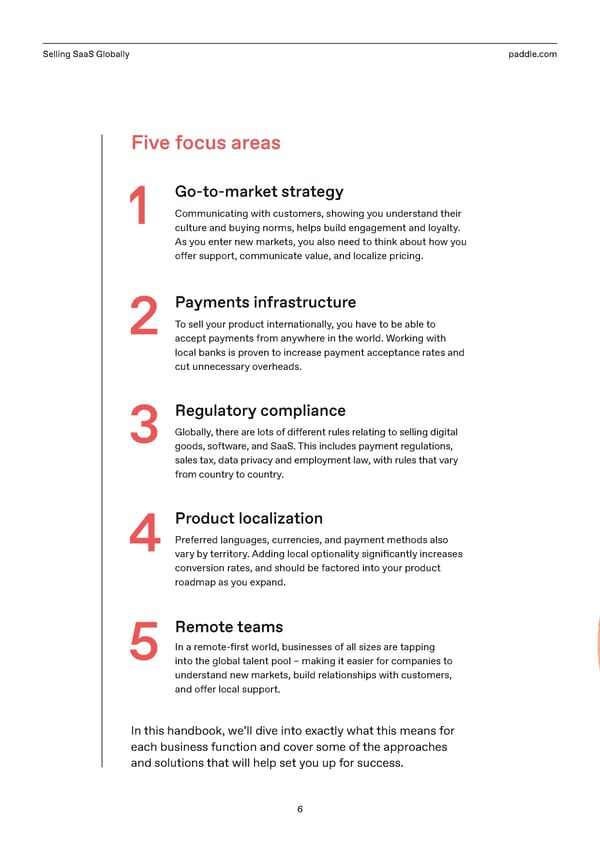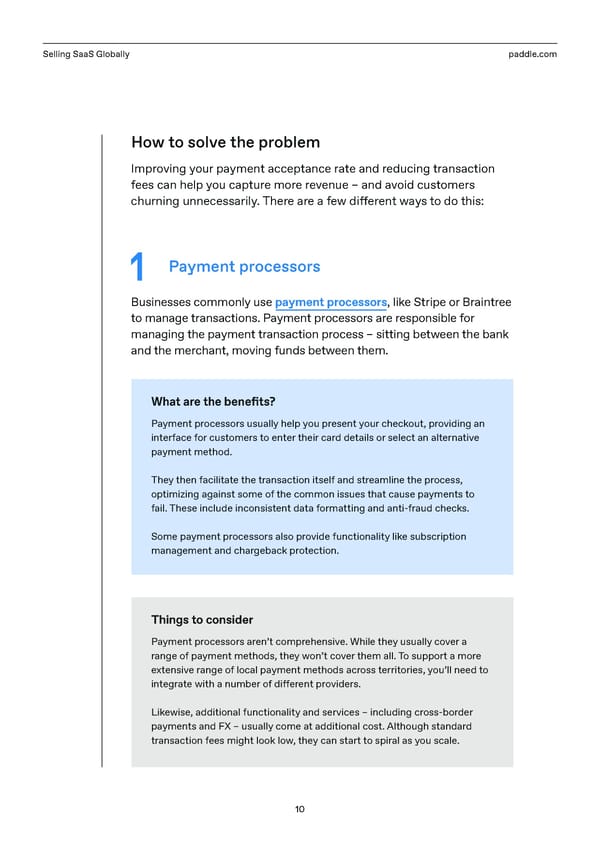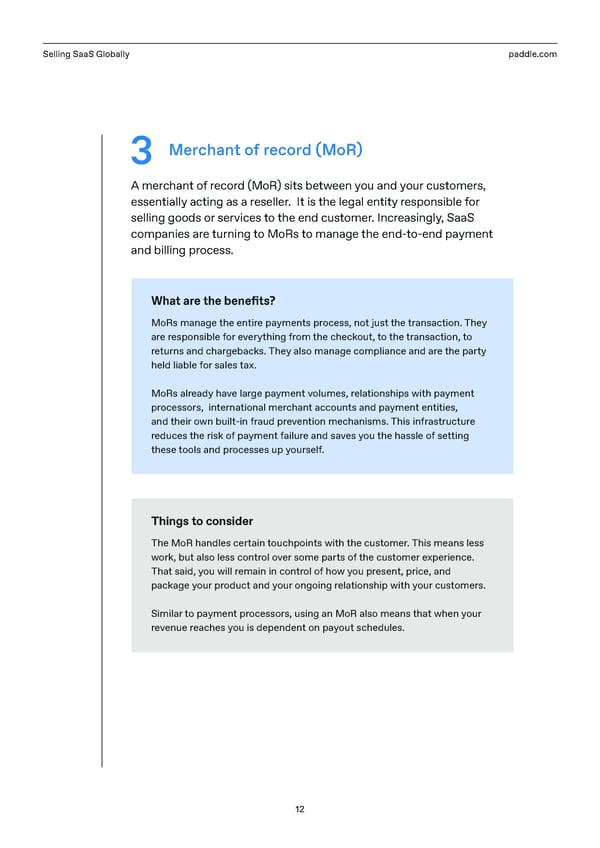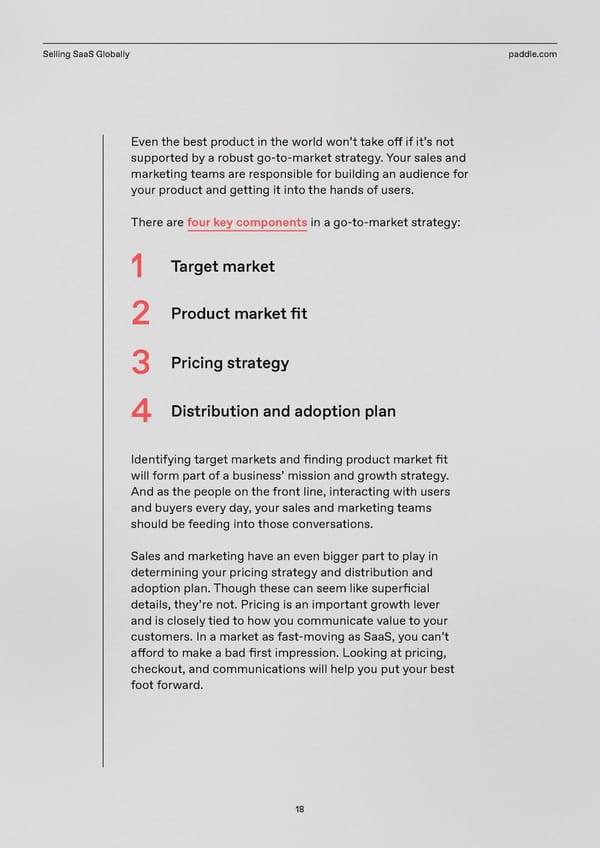Selling SaaS Globally | Handbook
A SaaS leader’s practical guide to global expansion
Handbook
Paddle
SaaS
Global Expansion
Marketing
Interactive Content
HANDBOOK Selling SaaS Globally A SaaS leader’s practical guide to global expansion
Paddle helps SaaS companies grow faster with fewer distractions. As a SaaS merchant of record, we take away the complexity of managing a ‘best in breed’ payments stack — handling all payment routing, tax collection, compliance, invoicing, subscription management, renewals, reporting, and fraud protection. Learn more at Paddle.com

Contents INTRODUCTION 4 Going global, thinking local PART ONE 7 Finance, legal, and operations • Payments • Sales tax and 昀椀nancial compliance PART TWO 17 Sales and marketing • Pricing • Checkout • Marketing communications PART THREE 26 Product and support • Product localization • Support PART FOUR 32 People and talent • Operations • Culture Selling SaaS globally: Final thoughts 39 Resources 40
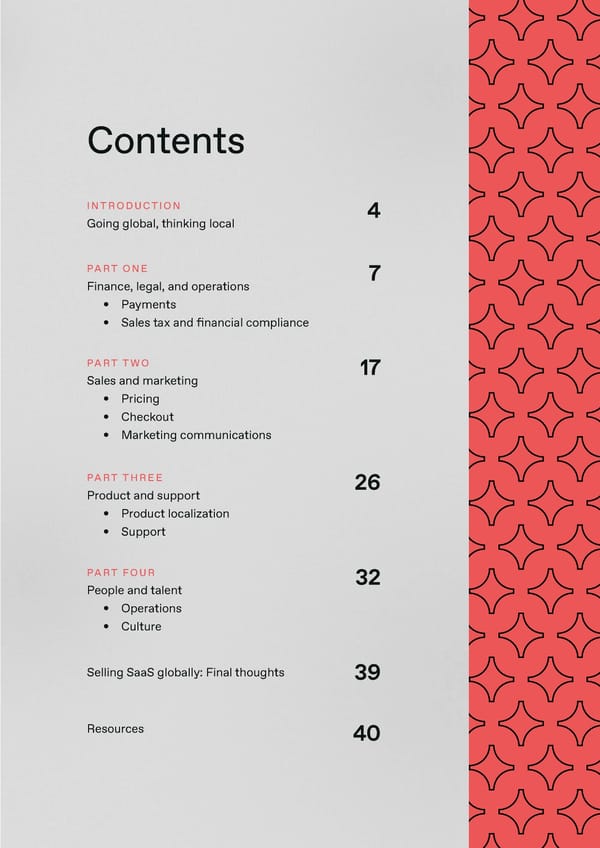
Selling SaaS Globally paddle.com Going global, thinking local 4
Selling SaaS Globally paddle.com The SaaS market is changing. Giant funding rounds and record breaking valuations are going to be harder to come by. And even when you do secure cash in the bank – the pressure is on to make sure you use it wisely. Now more than ever, SaaS leaders need to think strategically about which growth levers to pull. Where before this might have been a decision based on how rapidly the business could grow, it’s now one that needs to be based on e昀케cient growth that doesn’t expose the business to unnecessary risks. Expanding internationally undoubtedly opens up potential revenue and growth opportunities for SaaS. And it’s arguably “easier” than it is for other business models because, by its very nature, accessing new markets is possible without dedicated sales and marketing resources. But without strategy and intention behind your international expansion, you risk missing out on huge revenue potential from untapped markets – or falling victim to the barriers that trip too many SaaS businesses up on the way (sales tax compliance, anyone?). As you start building out your expansion strategy, there’s only one rule you need to remember: The secret to selling globally is thinking locally. Whether you’re building relationships with partners or customers, being aware of and adapting to local nuances is the best way to expand your international reach. As a SaaS company, there are a few critical areas to focus on. 5
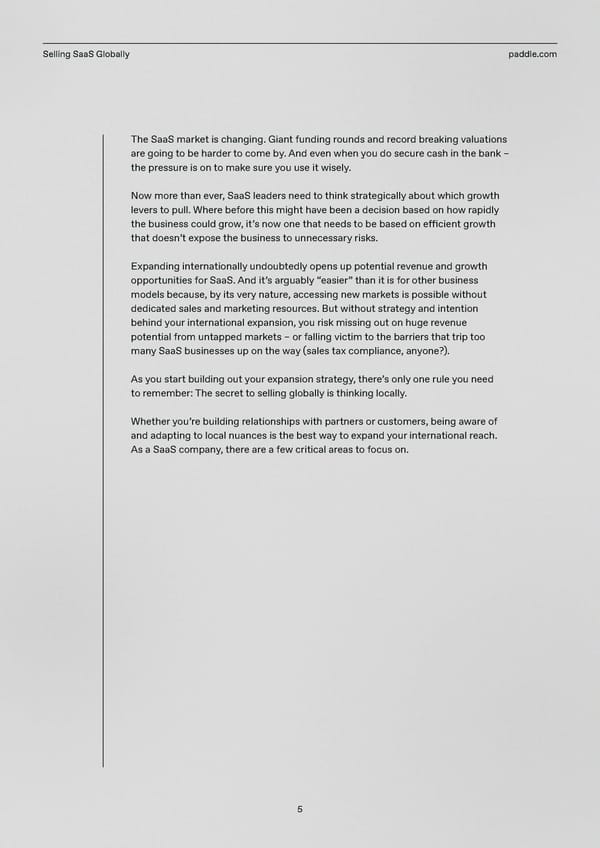
Selling SaaS Globally paddle.com Five focus areas Go-to-market strategy 1 Communicating with customers, showing you understand their culture and buying norms, helps build engagement and loyalty. As you enter new markets, you also need to think about how you o昀昀er support, communicate value, and localize pricing. Payments infrastructure 2To sell your product internationally, you have to be able to accept payments from anywhere in the world. Working with local banks is proven to increase payment acceptance rates and cut unnecessary overheads. Regulatory compliance 3Globally, there are lots of di昀昀erent rules relating to selling digital goods, software, and SaaS. This includes payment regulations, sales tax, data privacy and employment law, with rules that vary from country to country. Product localization 4Preferred languages, currencies, and payment methods also vary by territory. Adding local optionality signi昀椀cantly increases conversion rates, and should be factored into your product roadmap as you expand. Remote teams 5In a remote-昀椀rst world, businesses of all sizes are tapping into the global talent pool – making it easier for companies to understand new markets, build relationships with customers, and o昀昀er local support. In this handbook, we’ll dive into exactly what this means for each business function and cover some of the approaches and solutions that will help set you up for success. 6
Selling SaaS Globally paddle.com Finance, legal, and operations PART 7
Selling SaaS Globally paddle.com Finance leaders play a pivotal role in international expansion. As the position of the CFO continues to evolve, their input on strategic growth decisions is increasingly important. The teams that line into CFOs control the infrastructure that supports key operations including accounts payable and receivable, payroll, and tax. Without con昀椀dence in that team and infrastructure businesses cannot operate, let alone scale. With so much at stake, where should 昀椀nance, legal, and operations teams focus their attention to set themselves – and the business – up for success? Two important areas to prioritize are payments and compliance. Payments To sell globally, you need a payments infrastructure that enables you to route and ultimately accept payments e昀케ciently by: 1 Taking and receiving payment in di昀昀erent locations and across borders 2 Taking payments in di昀昀erent currencies 3 Supporting local payment methods 8
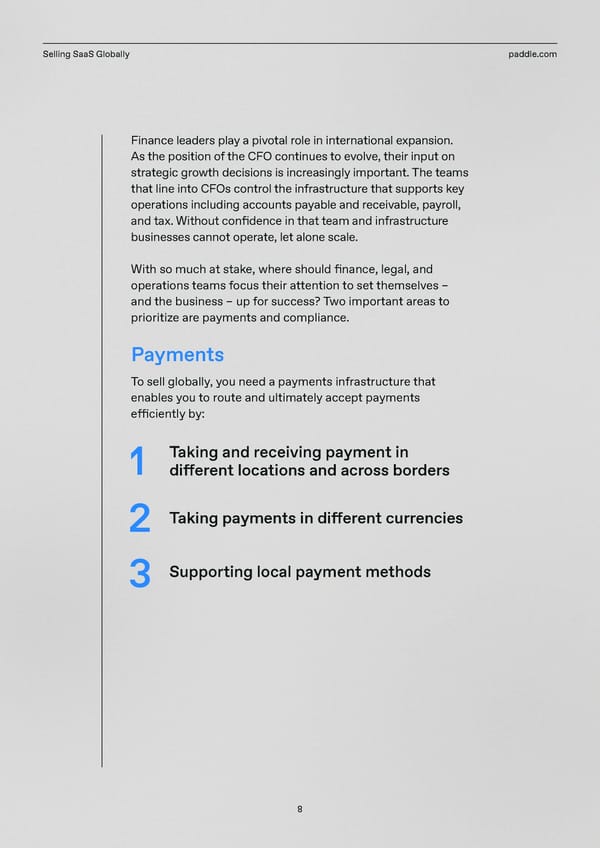
Selling SaaS Globally paddle.com Why is this a challenge? Payment failure issues and foreign exchange (FX) fees result in lost revenue and involuntary customer churn. While payments fail for a variety of complex reasons, the risk increases as you scale internationally. Thanks to longer payment chains and a lack of relationships between banks, there’s less trust. That increases the likelihood that legitimate transactions will be falsely 昀氀agged as fraudulent. Longer payment chains also result in additional costs. Making a payment across borders requires the involvement of more parties to process the transaction, each responsible for transferring the money a part of the way. Each of those parties charges a fee. Once you add on FX fees for converting one currency into another, overheads start to creep up. 9
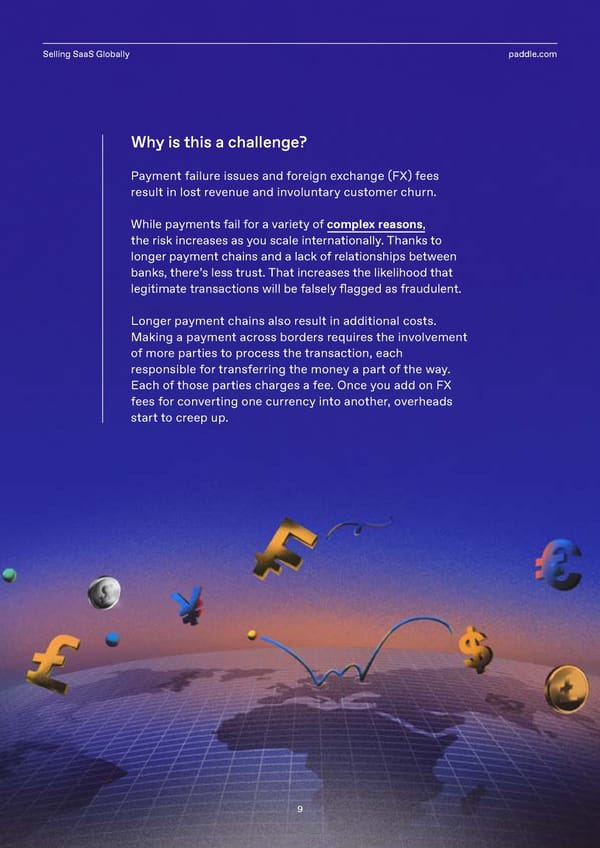
Selling SaaS Globally paddle.com How to solve the problem Improving your payment acceptance rate and reducing transaction fees can help you capture more revenue – and avoid customers churning unnecessarily. There are a few di昀昀erent ways to do this: 1 Payment processors Businesses commonly use payment processors, like Stripe or Braintree to manage transactions. Payment processors are responsible for managing the payment transaction process – sitting between the bank and the merchant, moving funds between them. What are the bene昀椀ts? Payment processors usually help you present your checkout, providing an interface for customers to enter their card details or select an alternative payment method. They then facilitate the transaction itself and streamline the process, optimizing against some of the common issues that cause payments to fail. These include inconsistent data formatting and anti-fraud checks. Some payment processors also provide functionality like subscription management and chargeback protection. Things to consider Payment processors aren’t comprehensive. While they usually cover a range of payment methods, they won’t cover them all. To support a more extensive range of local payment methods across territories, you’ll need to integrate with a number of di昀昀erent providers. Likewise, additional functionality and services – including cross-border payments and FX – usually come at additional cost. Although standard transaction fees might look low, they can start to spiral as you scale. 10
Selling SaaS Globally paddle.com 2 Local banks Setting up accounts with local banks in territories can help you overcome some of the common causes of payment failures, like miscommunication and longer payment chains. What are the bene昀椀ts? Payment failure is more likely when acquiring banks (those receiving money) and issuing banks (those sending money) are in di昀昀erent countries. Using acquiring and issuing banks in the same country – i.e. banking where your customers are – can help. Using local acquiring banks can increase payment acceptance rates by 2 20% for new customers, and by 3% for subscriptions and renewals. Things to consider It’s not a quick 昀椀x. Setting up a local bank account in every new geography is resource-intensive and can take months. Even with a local banking entity, you won’t be seen as a trusted seller by issuing banks until you’ve built up signi昀椀cant payment volumes. 11
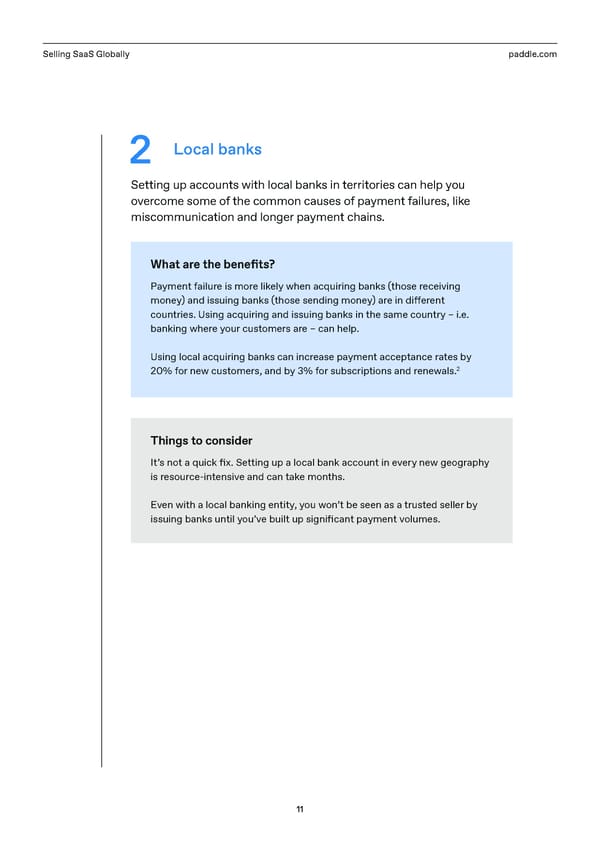
Selling SaaS Globally paddle.com 3 Merchant of record (MoR) A merchant of record (MoR) sits between you and your customers, essentially acting as a reseller. It is the legal entity responsible for selling goods or services to the end customer. Increasingly, SaaS companies are turning to MoRs to manage the end-to-end payment and billing process. What are the bene昀椀ts? MoRs manage the entire payments process, not just the transaction. They are responsible for everything from the checkout, to the transaction, to returns and chargebacks. They also manage compliance and are the party held liable for sales tax. MoRs already have large payment volumes, relationships with payment processors, international merchant accounts and payment entities, and their own built-in fraud prevention mechanisms. This infrastructure reduces the risk of payment failure and saves you the hassle of setting these tools and processes up yourself. Things to consider The MoR handles certain touchpoints with the customer. This means less work, but also less control over some parts of the customer experience. That said, you will remain in control of how you present, price, and package your product and your ongoing relationship with your customers. Similar to payment processors, using an MoR also means that when your revenue reaches you is dependent on payout schedules. 12
Selling SaaS Globally paddle.com Sales tax compliance To sell globally, you need a robust process for registering for, 昀椀ling, and remitting sales tax payments. This involves: 1 Monitoring changes in local and international tax rules 2 Accurately calculating how much tax is due in each geography 3 Filing and remitting your payments in accordance with the local tax authority’s schedule 13

Selling SaaS Globally paddle.com Rarely does a software founder start out considering tax compliance, yet when you grow successfully and internationally, it quickly becomes a serious and complex issue. Startups soon end up tripping over the sales tax thresholds in various countries, forcing emergency hires and reactive investments, attracting fines from various jurisdictions” Will Southgate Finance Director, Notion Capital Why is this a challenge? Custom regulation has now been introduced in more than 40 countries governing sales tax for digital goods, software, and SaaS products. Sales tax thresholds, rates, and periods vary not only between countries but also between the di昀昀erent jurisdictions within them. Filing systems and processes also di昀昀er – LATAM uses electronic invoicing, while Japan requires you to work with local agents to 昀椀le your taxes. The USA alone has 11,000 di昀昀erent tax jurisdictions. Here, sales tax rates and thresholds vary across di昀昀erent states, cities and – in one case – even a large McDonald’s. This degree of variation makes it very di昀케cult to keep on top of your obligations, or to automate processes for meeting them. And changes to tax regulations are ongoing. Monitoring the landscape and ensuring processes are aligned to new rules can become a full time, multi-person job. While it’s theoretically possible to manage in-house, sales tax takes a huge amount of energy and can soon become overwhelming for lean, scaling teams. 14
Selling SaaS Globally paddle.com 38% increase in the size of EY’s annual Worldwide VAT, GST, and Sales Tax Guide, from 1,300 pages in 2019 to 1,800 in 2022 Source: EY Worldwide VAT, GST, and Sales Tax Guide How to solve the problem Putting tools in place can save additional headcount costs, and reduce your risk of being hit with expensive non-compliance penalties. Two options to manage the burden are: 1 Sales tax software Sales tax software provides tools that help you understand how much sales tax you owe by automating the calculation process. It can be used by your in-house team or by independent agents. What are the bene昀椀ts? Implementing software to automate repetitive manual tasks is much cheaper and more scalable than hiring full-time sta昀昀. It makes it easy to calculate tax owed across di昀昀erent jurisdictions and stay up to date with any changes to regulations, saving time and giving you con昀椀dence when it comes to 昀椀ling. Things to consider While software can calculate tax owed, it can’t automate 昀椀ling or payment due to the variations in rates and processes across jurisdictions. Tax software doesn’t take on liability, either. If there’s a mistake in your returns, you’re still responsible for penalties. 15
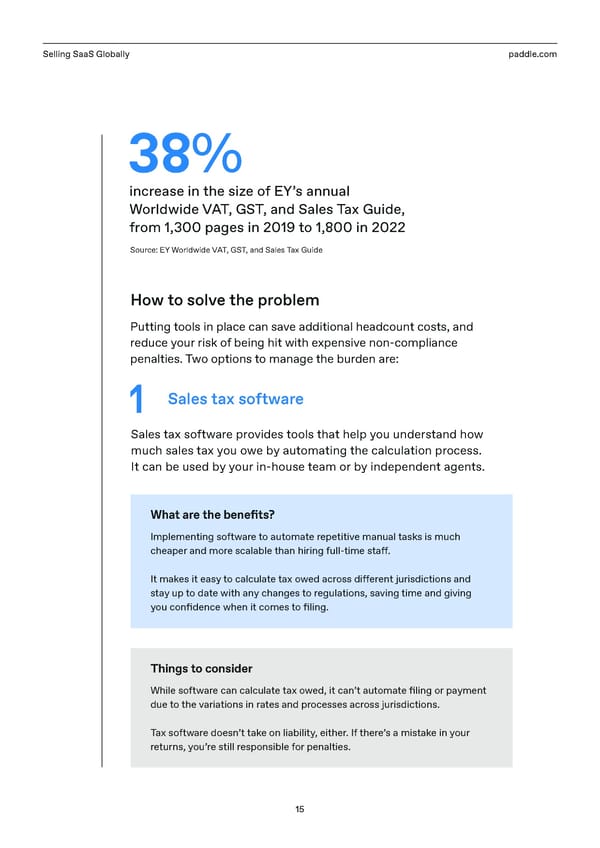
Selling SaaS Globally paddle.com 2 Merchant of record As a reseller, the MoR is the legal entity responsible for transactions and, as such, take responsibility for any sales tax liability on those transactions. What are the bene昀椀ts? As the liable party, the MoR is responsible for calculating, 昀椀ling, and remitting sales tax. That saves your business hours of manual work and removes risk. It also helps keep your books ‘clean’, which is valuable during the due diligence process that forms part of a fundraise or IPO. Things to consider In order to become the liable party, the MoR needs to appear on certain payment receipts or statements. However, this doesn’t usually impact conversion rate and due to optimized payment processes developed by the MoR, payment acceptance is likely to increase overall. 16
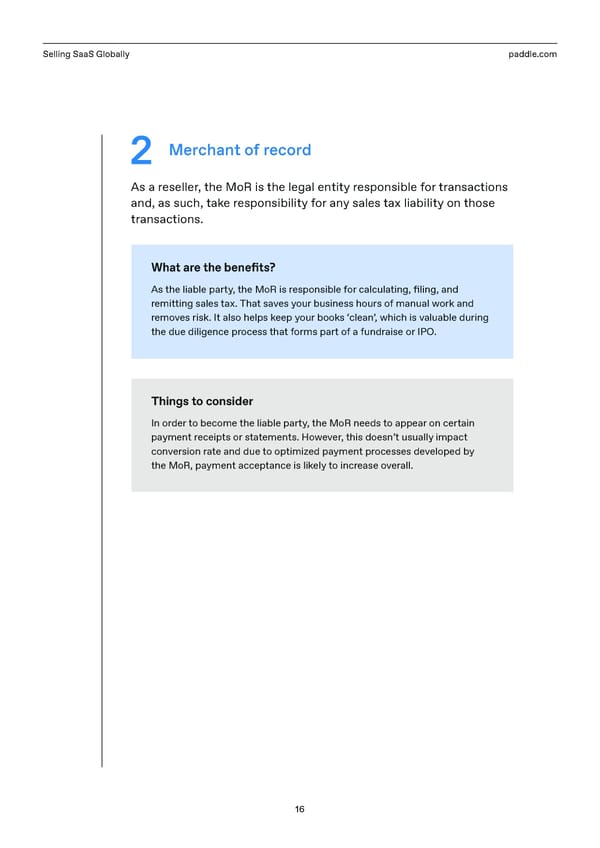
Selling SaaS Globally paddle.com Sales and marketing PART 17
Selling SaaS Globally paddle.com Even the best product in the world won’t take o昀昀 if it’s not supported by a robust go-to-market strategy. Your sales and marketing teams are responsible for building an audience for your product and getting it into the hands of users. There are four key components in a go-to-market strategy: 1 Target market 2 Product market 昀椀t 3 Pricing strategy 4 Distribution and adoption plan Identifying target markets and 昀椀nding product market 昀椀t will form part of a business’ mission and growth strategy. And as the people on the front line, interacting with users and buyers every day, your sales and marketing teams should be feeding into those conversations. Sales and marketing have an even bigger part to play in determining your pricing strategy and distribution and adoption plan. Though these can seem like super昀椀cial details, they’re not. Pricing is an important growth lever and is closely tied to how you communicate value to your customers. In a market as fast-moving as SaaS, you can’t a昀昀ord to make a bad 昀椀rst impression. Looking at pricing, checkout, and communications will help you put your best foot forward. 18
Selling SaaS Globally paddle.com Pricing Thinking strategically about pricing models and putting processes in place to ease handover from sales to finance can help you capture more revenue, faster. Your pricing strategy needs to consider: • What drives product value in each market • Di昀昀erent pricing models • The technology needed to support di昀昀erent billing models Why is this a challenge? Establishing the right price for your product is not as simple as picking a number. You need to consider willingness to pay across your customer segments, and your product value in di昀昀erent markets – both of which will change over time. Willingness to pay refers to the perceived value of your product in the market. It changes from customer to customer and market-to-market. Here, seasonal trends, the state of the economy, the competitive landscape, and how you di昀昀erentiate yourself all come into play. Perception of value can also be a昀昀ected by your pricing model. If your customers are using your product daily then charging one 昀氀at monthly subscription fee feels like a good deal. If they only use it occasionally, they might see things di昀昀erently. 19
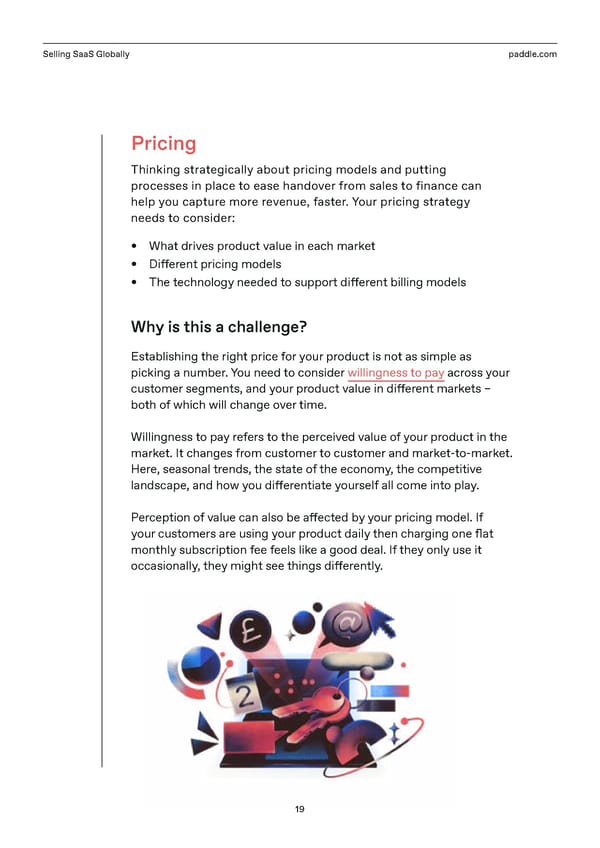
Selling SaaS Globally paddle.com How to solve the problem 1 Research product value To get a holistic view of your product’s comparative and absolute value, your product, sales and marketing teams will need to work together. They’ll need to: • Look at the objective value of your product (ie. its features, and if/where there are variations in availability) • Map that value to customer needs • De昀椀ne your unique selling points (USPs) against local competitors What are the bene昀椀ts? Understanding the nuance of product value is critical to help you decide an appropriate price point for each market. It also gives sales and marketing teams the material to create compelling messaging that communicates tangible value to customers. 2 Choose the right pricing model SaaS businesses use a variety of di昀昀erent pricing models. Some of the most common include: • Fixed: One 昀氀at rate for all features, with no limit on number of users or projects. • Tiered: Di昀昀erent rates for di昀昀erent combinations of features, or levels of access, eg. basics/standard/premium packages. • Usage based: A variable rate based on how much the product is used; essentially ‘pay as you go’. • Per seat: A rate charged for each user or license holder. As your product grows into new markets, you may need to change your pricing model to match your product value. What are the bene昀椀ts? Experimenting with pricing models can be a signi昀椀cant driver of growth. 40% of companies that regularly alter their pricing report a 25% higher 1 increase in ARR as a result. 20
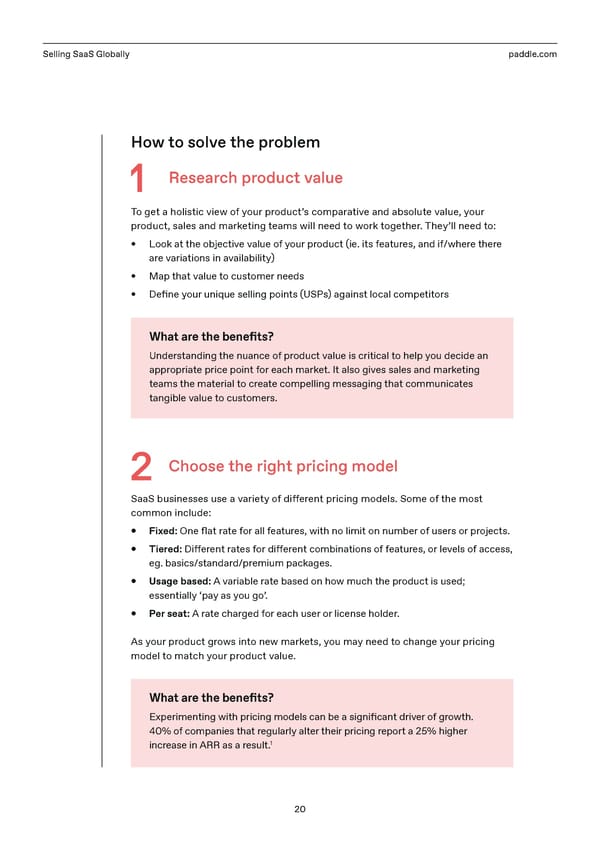
Selling SaaS Globally paddle.com 3 Implement a CRM Customer relationship management (CRM) software helps track all touchpoints with targets from first outreach, to billing, to marketing, and beyond. It can help automate sales operations, like invoicing and contract management. As you expand internationally, CRMs can help you send invoices and contracts that are compliant in each geography, and translated into local languages. What are the bene昀椀ts? Used consistently, CRMs enable you to keep your payment, sales, and billing data consistent. This is important as you grow; while manual revenue recognition is easy enough with a small pool of clients, accuracy can su昀昀er as it expands. CRMs also ease friction for 昀椀nance teams downstream, by ensuring sales teams send contracts and invoices correctly, so revenue can be collected quicker. 21
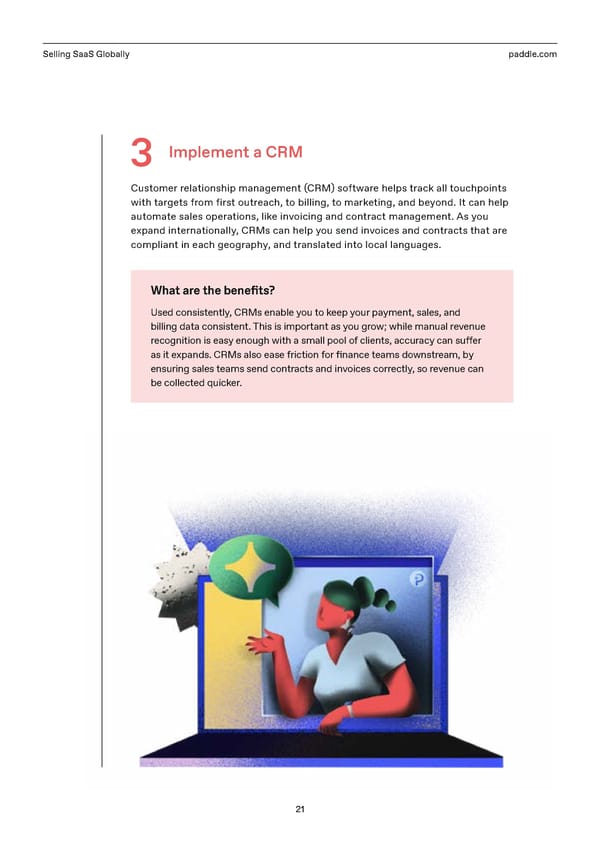
Selling SaaS Globally paddle.com Checkout For businesses using a product-led model either entirely or in addition to a sales-led motion, selling globally is dependent on your checkout. And that means making it easy for customers to pay according to their local preferences by supporting a range of local payment methods and accepting local currencies in your checkout. Why is this a challenge? Customers in di昀昀erent parts of the world have very di昀昀erent preferences when it comes to payment methods. In Germany, around 50% of sales under $50 are paid for through digital wallets. Meanwhile, in China, AliPay is trusted by 81% of consumers. By adding optionality at checkout, you’ll be able to service a 6 larger portion of your target market. Likewise, charging in a local currency can boost payment acceptance by as much as 9%, while enabling multiple currencies can help your business grow faster overall, outstripping competitors by 26%. If you can’t accept di昀昀erent currencies, you’ll have to pay FX fees to convert them, and that increases the likelihood of cross- 6 border payment failure. 22
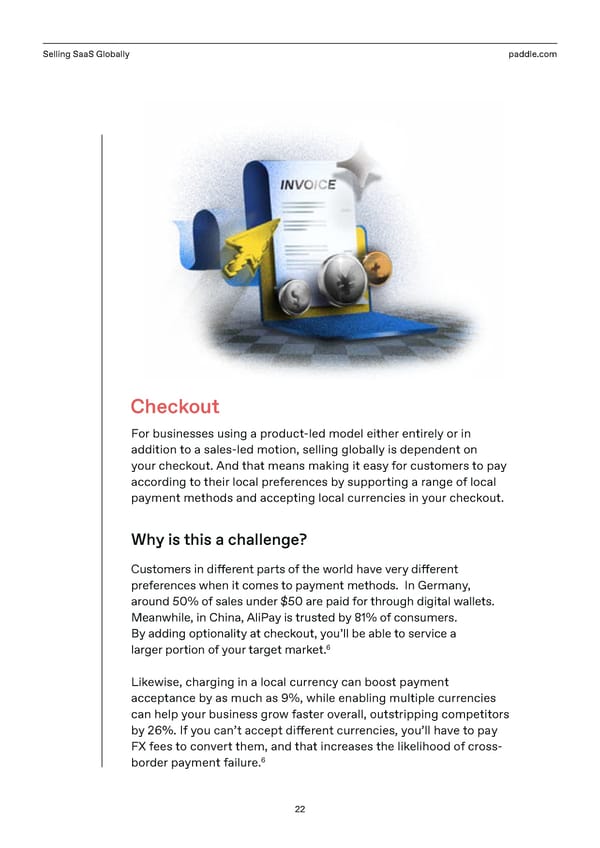
Selling SaaS Globally paddle.com How to solve the problem 1 Payment processor Payment processors typically o昀昀er multiple payment methods and currencies. What are the bene昀椀ts? Payment processors give you access to a range of di昀昀erent currencies, and the use of di昀昀erent payment methods, without you having to build functionality yourself. This frees up expensive product and technical team time for more strategic work. Things to consider Few, if any, payment processors are able to support the complete range of currencies and payment methods. To get full global coverage, you’ll need to integrate with di昀昀erent payment processors in each geography. This requires engineering time, taking away from your product development, and means incurring costs from multiple vendors. 2 Merchant of record As a reseller and uni昀椀ed solution, MoRs will be integrated with multiple payment processors and are often able to o昀昀er more payment options out-of-the-box as a result. What are the bene昀椀ts? Working with MoRs lets you tap into a global payment network through a single integration point. This reduces backend complexity for product teams because you can achieve the same (or better) results from one integration. Things to consider While they are likely to have more payment options ready for you to “turn on” right away, new payment methods are gaining traction all the time. It could take time for new payment methods, like crypto currencies to make their way on to an MoR’s product roadmap. 23
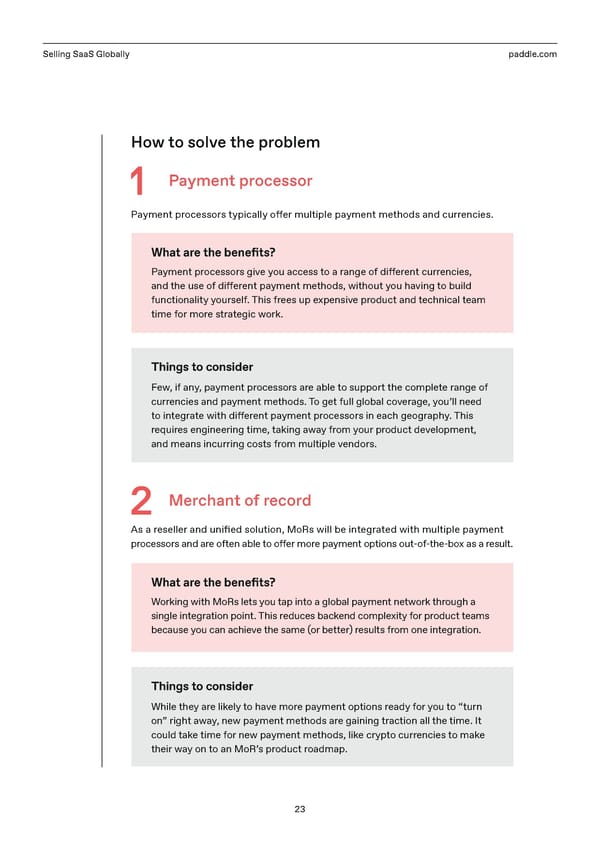
Selling SaaS Globally paddle.com Marketing communications To attract and retain customers across markets, you need to understand their specific motivations, pains, and cultural contexts, and adapt your communications accordingly. To help improve engagement and win share of voice, you should: • Research your target buyers and the competitive landscape in each geography • Adapt both messaging and language • Leverage partners to grow trust and local traction • Understand and comply with local privacy regulations Why is this a challenge? If you can’t speak to customers in their language and in a way that respects their culture, you’ll struggle to win the trust and attention of a large share of your target market. The numbers are significant: while much of the world’s population speaks English, it’s only the preferred language for 26% of people globally. One in five prefer Chinese, and 8% prefer Spanish.4 That means a localized marketing strategy presents a much bigger opportunity than an English-only strategy. In addition to understanding the expectations and nuances in different markets, you also need to make sure that your marketing and seller communications are compliant with local regulations. This covers things like GDPR in Europe or the California Consumer Privacy Act (CCPA). There’s a lot to consider. Even down to the types of email you can send to customers – the rules around that aren’t the same. What you can send to customers in the US is different from what you can send to customers in Germany.” Peter Nesbitt COO, TeamPay 24
Selling SaaS Globally paddle.com How to solve the problem 1 Conduct region-speci昀椀c research As you target new markets, conduct research to inform your go-to-market strategy. Some things to consider: • Local competitors • Marketing channel preferences • Tone and messaging preferences • Search terms and SEO keywords relating to your product that will help target users 昀椀nd your website What are the bene昀椀ts? Identifying cultural and linguistic nuances can help you avoid alienating customers and capture a greater share of search tra昀케c. The US and the UK share the same language, but di昀昀erent usage: an SEO strategy that’s optimized for car instead of automobile will su昀昀er in the US. 2 Regionalize campaigns and content Translate all content, including website, email, advertising, and SEO keywords, and create regional newsletters and content where possible. This is a considerable undertaking, so initially you should think strategically about where and when translation will be most valuable. What are the bene昀椀ts? Content that feels personalized to your target market performs better. Localizing post-purchase emails alone can increase click-through rate by 52%.4 3 Work with local partners Partner with local thought leaders, in昀氀uencers, and distribution partners to leverage their audience while you grow your own. If you have 昀椀eld teams, create frameworks within which they can adapt and repurpose centralized campaign materials. What are the bene昀椀ts? Working with brands your audience already recognizes and trusts helps you raise awareness quickly as you enter new markets. Similarly, team members that are already on the ground should have a good understanding of what will and won’t work. Trusting them to tailor global messages to local audiences will save you having to develop multiple campaigns from scratch. 25
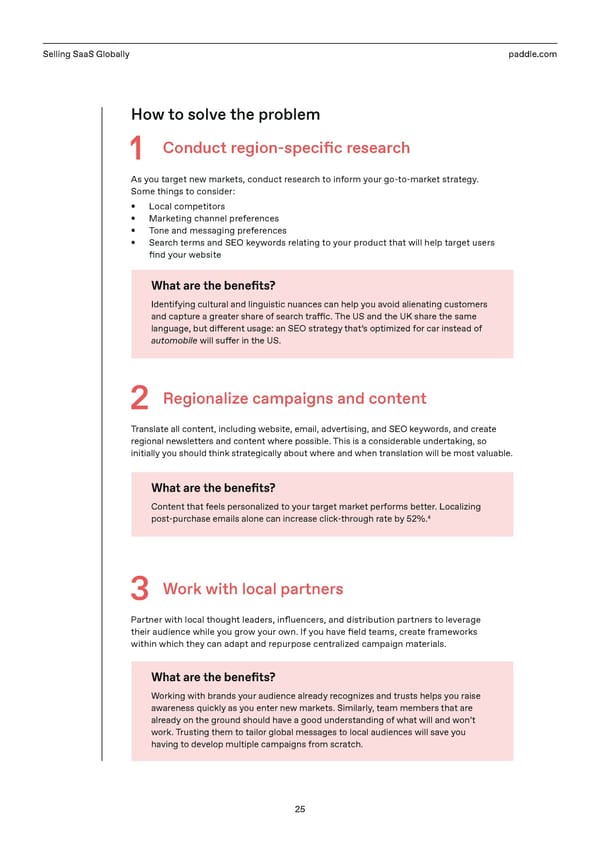
Selling SaaS Globally paddle.com Product and support PART 26
Selling SaaS Globally paddle.com Even with broad reach, SaaS businesses need strong market fit to see meaningful traction in new territories. Different markets will have different needs and expectations of your product and support services. Meeting those needs might require you to build bespoke functionality or partner with other local solutions that already offer it. Understanding the total addressable market (TAM) and competitive landscape in each geography will help you decide what to prioritize, what to optimize, and where your product has the best chance of success. To ensure you’re building a product that customers want, and to make it easy for them to use and see value from it, you should concentrate on two things: product localization and support. 27
Selling SaaS Globally paddle.com Product localization Light-touch changes can help you meet with different customer expectations in different markets, and increase engagement with your product. You need to: • Ensure your product supports multiple languages and scripts • Translate all copy and collateral, especially technical documentation • Conduct market research to identify cultural di昀昀erences between territories Why is this a challenge? When done well, product localization can increase customer satisfaction and engagement and grow your customer base in new markets. When done badly, it can mean products feel ill-suited or impersonal, causing customers to drop o昀昀 and seek out your competitors. But often, product localization is an afterthought – if it’s not overlooked entirely. That’s because it’s seen as interfering with growth, not supporting it. Having to repeatedly tweak your product before you launch it can be more resource-intensive than it seems, and slows down your time to market. It can also be di昀케cult to balance against bigger items on your development roadmap, which may be seen as more strategically important. It becomes more challenging as you scale. Unless you have native speakers on your team from every single target market, you’ll need to employ translators or translation tools – adding more expense and slowing development further. 28
Selling SaaS Globally paddle.com How to solve the problem 1 Research your target market in detail There’s more to culture than language. Conducting market research can help you understand the cultural nuances which might impact your product strategy in each geography, like tone of voice or color palette. What are the bene昀椀ts? Ideally, good localization will feel like an original and unique experience – not something that’s been translated or adapted. This avoids alienating your target audiences. 2 Display information according to local conventions Software localization ensures your product can support each market’s required functionality and user interface conventions. It includes support for di昀昀erent date and time displays, currencies, and scripts, especially: • Double-byte languages (like Japanese) • Languages with complex scripts (like Hindi) • Right-to-left languages (like Hebrew) What are the bene昀椀ts? Software localization improves the user experience, making your product accessible and easy to use for as many potential customers as possible. This enables you to expand your customer base in new markets. 3 Speak the local language Language localization involves enlisting translators or software to create localized in- app and UX copy, and onboarding collateral. Work with translators to ensure all product copy is optimized for both users and search engines in each geography you enter. What are the bene昀椀ts? 75% of customers prefer to make buying decisions in their native 14 language. Working with native speakers either as translator or during QA rather than relying solely on translation software avoids awkward phrasing, and helps smooth out the customer experience. 29
Selling SaaS Globally paddle.com Support Once your product is in the hands of users, you also need to consider how you help them use it. Your support offering should: • Reduce friction that could turn customers onto local competitors • Make it easy for them to troubleshoot issues when they inevitably arise • Provide prompt solutions across time zones • Be of the same standard regardless of where the customer is based Why is this a challenge? Customers have high expectations: 51% want businesses to be available 11 24/7, and if you can’t meet their needs, they might go elsewhere. Providing full time support across every timezone is a mammoth task. It can require a huge headcount across multiple di昀昀erent o昀케ces, which is expensive to implement and challenging to centrally manage – especially if some of that headcount is also remote. These issues are made more complicated by the fact that customers in di昀昀erent geographies have di昀昀erent preferences about how they contact you, too. In Asia, WeChat is popular, and businesses globally are starting to use Facebook Messenger and Whatsapp alongside traditional phone and email channels. 30
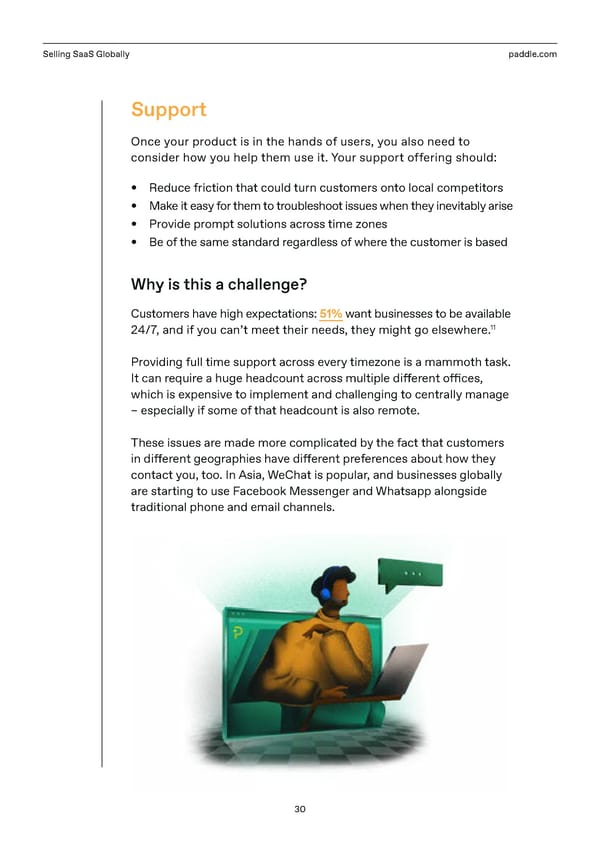
Selling SaaS Globally paddle.com How to solve the problem 1 Establish a support ethos A support ethos establishes where, when, and how your business will deploy support in each new geography. Some use a ‘follow the sun’ methodology, o昀昀ering consistent support from teams in di昀昀erent timezones. Others employ a support team that works a shift pattern out of their HQ. What are the bene昀椀ts? Thinking strategically about whether you provide live support or automated self-serve, 24 hours or o昀케ce hours, by phone or by digital channels can help you provide maximum coverage and customer satisfaction. This approach also keeps costs lower, as you avoid the need to hire out of hours and weekend sta昀昀 that work for higher rates. 2 Automate support channels Not all support requests will require human intervention. Simpler issues can be tackled by empowering users to self-serve their way to a solution. This is achieved by improving your documentation, FAQs and help center, or by implementing chatbots. What are the bene昀椀ts? Automating support channels reduces the volume of tickets being created, as customers are empowered to help themselves. It also helps you deploy budget more e昀케ciently, freeing up expensive human resource to focus on more strategically valuable work. 3 Implement QA processes Quality Assurance (QA) is the process of reviewing customer service conversations in order to deliver consistently high-quality support. QA can be performed by existing team members with the support of frameworks and technology, or can be a full-time role. What are the bene昀椀ts? QA ensures that the increase in tickets as you scale does not result in a decrease in response quality. It takes the burden of review away from support team leads, so they can concentrate on management rather than execution. 31
Selling SaaS Globally paddle.com People and talent PART 32
Selling SaaS Globally paddle.com Having the right people in place at every growth stage can make or break your business. But 21% of the European tech community thinks hiring talent will be their greatest challenge in the next 12 months.3 There are two things for fast-growth businesses to consider when it comes to building a best-in-class team. 1 Hiring for growth Someone who was a star employee when you were a 10-person company may not be the right fit to lead a team of 50 – or 150. And that may be just 18 months later. 2 Hiring for culture Scaling internationally means both supporting your internal culture, and aligning with that of your customers. Knowing who your team needs, how to 昀椀nd them, and crucially, how to grow and retain them is what supports business’ growth and creates a strong company culture. Though People decisions can often feel emotional, they should be underpinned by thorough processes that help you scale, while remaining compliant. Here are some of the challenges you might face and how to overcome them. 33
Selling SaaS Globally paddle.com Operations Today, companies of all sizes are hiring globally. The kicker for SaaS scale ups is that the operational burden and compliance expectations are the same whether you’re a company of 50 or 5,000. To grow your team sustainably, you’ll need to work with 昀椀nance and legal teams to: • Understand variation in international employment laws • Ensure core processes are set up to track and maintain compliance I speak to companies now that have 50 employees from 14 different countries. This is something that in the past would only have been seen in a Fortune 500 company.” Peter Nesbitt COO, TeamPay Why is this a challenge? How you choose to register your business will impact the way in which you are able to hire. In some countries businesses can register exclusively as a hiring entity. In others you’ll need a local business entity or an employer of record based elsewhere to hire local talent. As with payments and tax, employment regulation varies across jurisdictions. The laws by which employees are governed can depend on where they are from as well as where they are working. The a昀昀ected policies are wide-ranging, including Leave and Absence, Compensation, Pensions and Bene昀椀ts. There are also di昀昀erent rules that apply to full-time employees and independent contractors. 34
Selling SaaS Globally paddle.com How to solve the problem With so many moving parts when it comes to hiring staff internationally, it’s important to have clear visibility over your employees and people processes. Some businesses manage this internally, with the help of project management tooling and external advisors. Others outsource to a professional employer organization (PEO). Some use a combination of both: 1 In-house If you’re going it alone, there are a variety of tools you can use to empower your dedicated in-house people and talent team to manage international hiring and employees. Teams can use these tools to send automated reminders to track important dates for compliance and ensure you’re following labor laws in each country. What are the bene昀椀ts? Using software is cheaper than outsourcing to PEOs. There are a number of tools to help with di昀昀erent areas of people management: • Collaborative working and project management tools like GSuite, Asana, and Monday.com work well for global teams, and should be able to scale with you wherever you are. • Cloud-based human resources, contract signing, and applicant tracking systems can help you manage global and remote people operations more e昀昀ectively. Things to consider You may still need to rely on PEOs or employment law specialists as advisors, which can be expensive. Stitching together various tools to track and manage processes creates work昀氀ows which can be laborious to update. Multiple tools also means multiple sources of data that can create confusion if you don’t have robust processes to ensure hygiene across your tools. 35
Selling SaaS Globally paddle.com 2 Professional employer organization (PEO) Sometimes known as employer of record services, PEOs enter into a joint-employment relationship with you, essentially leasing employees to you. What are the bene昀椀ts? Using PEOs can ease the burden of registering as an entity in every new territory. This avoids the need for big investments and makes it quicker for you to start hiring in new geographies. It also reduces risk, as PEOs take on liability at the legal entity level. Things to consider As with MoRs, you might feel a lack of control and visibility over core processes. PEOs can also be expensive. They typically charge per employee and can 13 cost between 2-12% of wages. 36
Selling SaaS Globally paddle.com Culture A strong company culture helps to increase employee engagement and, in turn, productivity and alignment across teams. Hiring globally means embedding this culture across all geographies by: • Flexing salary and bene昀椀t packages to align with local benchmarks • Establishing e昀昀ective communication with teams • Commitment to meaningful diversity, equity, and inclusion (DE&I) initiatives Why is this a challenge? Entering new global markets opens up access to international talent pools. But with a global skills shortage, talent is still hard to 昀椀nd, harder to win, and expensive to retain. Culture is a critical part of solving that problem; people are increasingly looking for value alignment before they accept new roles. As you scale, your company culture will need to 昀氀ex to meet the expectations of your employees in each market. Salaries for the same role can vary signi昀椀cantly in di昀昀erent territories, as can the bene昀椀ts that employees value. How to solve the problem 1 Benchmark salaries Benchmarking salaries against industry standards helps you identify the market rate for roles – and make sure you position your open roles competitively. You can use free tools like Glassdoor, LinkedIn, and Indeed.com to get an idea of salaries across di昀昀erent markets. There are also paid-for survey data options that might have larger or more segmented samples. What are the bene昀椀ts? Salary benchmarking gives you an objective way to measure compensation. It avoids tensions that can arise when salary decisions are based on managerial perceptions of value rather than subjective appraisals. 37
Selling SaaS Globally paddle.com 2 Adapt reward packages You should develop a compensation philosophy for your business. This should incorporate the total reward package, not just salary. Changing the range of bene昀椀ts you o昀昀er – like pension, shares, learning budget and 昀氀exible hours – to align with what employees value in each geography can improve your employer brand. What are the bene昀椀ts? 60% of candidates consider the bene昀椀ts on o昀昀er before accepting a role, while 61% say bene昀椀ts boost their job satisfaction. Adapting your total reward package can make your o昀昀ering more attractive in competitive 12 markets without having to increase salaries. 3 Invest in onboarding and communication tools Your culture will need to be supported by clear communications to ensure it’s embedded and upheld by every employee. There are a number of ways you can make this happen: • Develop a robust onboarding programme to allow new joiners to meet di昀昀erent people across your entire business and get a feel for the company. • Use instant messengers, like Slack, to enable better communication, collaboration, and alignment between those who aren’t in the same o昀케ce. • Use employee engagement surveys to gauge their sentiment and encourage questions and feedback. What are the bene昀椀ts? • Using software to facilitate employee onboarding is cheaper and more inclusive than embedding several remote People teams (though it might help to invite new joiners to HQ initially as well). • Employees may feel more comfortable sharing feedback anonymously than they would face-to-face. • Giving them the opportunity to feed back regularly enables you to track issues as they arise and pre-emptively address problems that may lead to attrition. 38
Selling SaaS Globally paddle.com Selling SaaS globally: Final thoughts There’s a lot to it, but by taking the time to strategize how you sell globally, and set your team up for success, you’ll realize the rewards more quickly – and more sustainably too. The recommendations in this handbook were put together based on our experience and data from working with thousands of software and SaaS businesses around the world, as well as insights from our investors and peers in the SaaS space. We also drew on the experience of our internal experts, who are helping Paddle scale to new heights globally. 3939
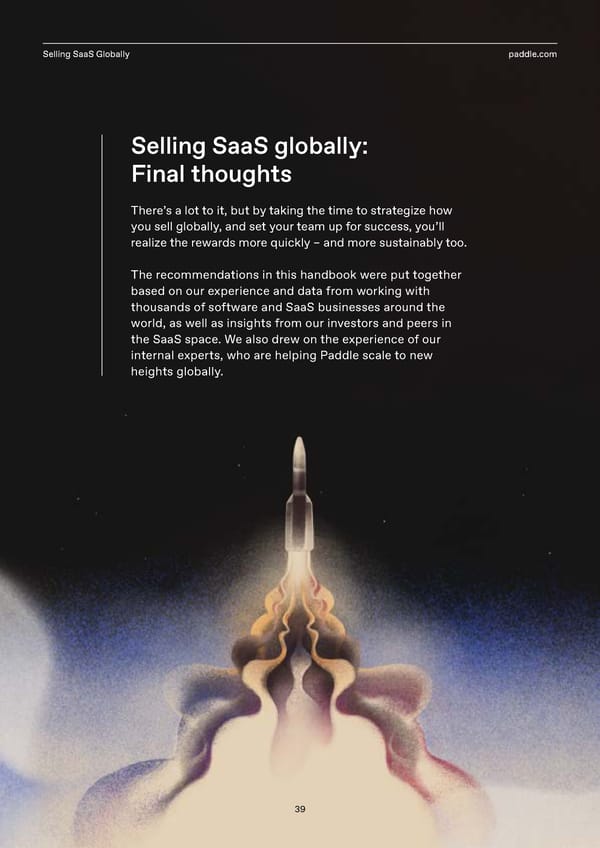
The only complete provider of payments infrastructure for SaaS companies Learn more at Paddle.com References 1 Paddle, The state of Saas growth 2 Paddle, 6 reasons for low payment acceptance 3 Paddle, Why payment processors aren’t 昀椀t for SaaS (Aug 2021) 4 Paddle, Introducing our new product updates to help you sell globally (Nov 2021) 5 Paddle, A conversation with Peter Nesbitt (Mar 2022) 6 Paddle, Selling SaaS internationally: When global becomes local (Jun 2021) 7 Developer.Paddle, Alipay 8 Paddle, How to build a go-to-market strategy 9 Paddle, The State of SaaS 2022: A Meta Report (Mar 2022) 10 Atomico, The State of European Tech 2021 (Dec 2021) 11 Tech Jury, Christo Petrov, 70+ Live Chat Statistics Your Business Needs in 2022 (Apr 2022) 12 Human Resources Director, Coann Labitoria, Salary vs employee bene昀椀ts: which is better to o昀昀er? (Nov 2021) 13 ADP.com, Resources, What is the cost of a PEO? 14 CSA Research


